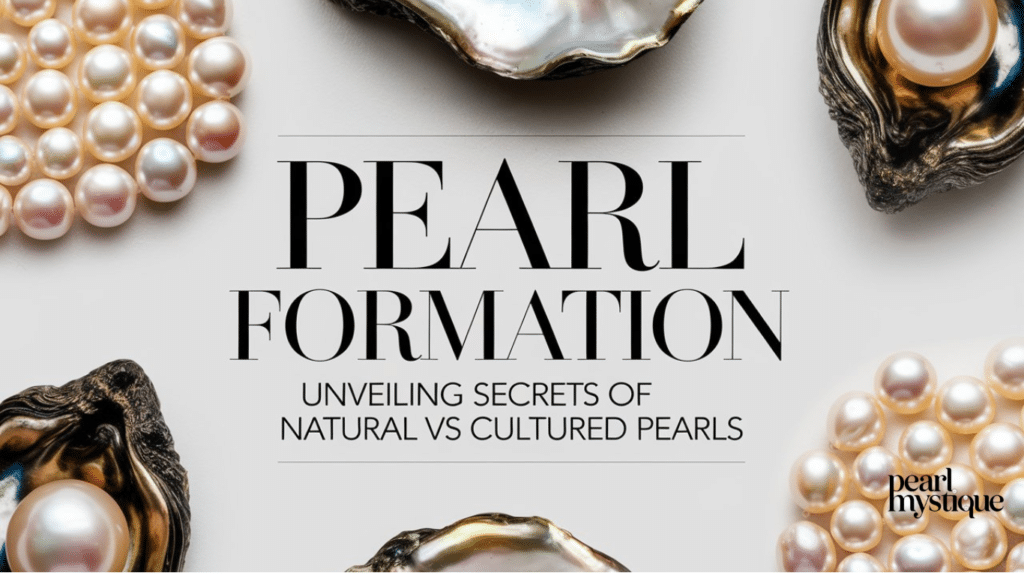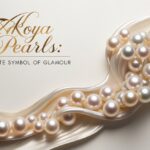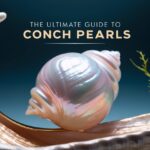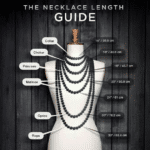Understanding Pearl Formation
Pearls have captivated humanity for centuries, symbolising purity, wealth, and beauty. From ancient royal courts to modern jewellery collections, pearls hold a unique place in both history and culture. Yet, the mystique surrounding pearls often leads to questions: How are pearls made? What’s the difference between natural and cultured pearls? In this comprehensive guide, we’ll dive deep into the process of how pearls are formed and explore the differences between natural and cultured varieties of pearls, and uncover their cultural significance. The Ultimate Guide to Pearl Formation and the Secrets to the Natural vs Cultured Pearls will enhance your knowledge about pearls a lot!
What Are Pearls?
Certain species of molluscs, primarily oysters, form pearls as organic gems. Unlike other gemstones that miners extract from the earth, living organisms produce pearls.Their beauty lies in their iridescent luster, a result of light interacting with layers of nacre, also known as mother-of-pearl. This Ultimate Guide to Pearl Formation will take you deep under the world of pearls.
The Science Behind Pearl Formation
Pearl formation is a fascinating biological process. It begins when an irritant, such as a parasite or a piece of shell, becomes trapped inside the mollusc’s shell. To protect itself, the mollusc secretes layers of nacre around the irritant. Over time, these layers build up to form a pearl. Check out The Ultimate Guide to Pearl Formation below for further details.
Natural vs. Cultured Pearls: An Overview
Natural pearls form without human intervention, making them incredibly rare. In contrast, humans create cultured pearls with assistance. In cultured pearls, a technician inserts a nucleus into the mollusc, which then coats the nucleus with nacre, forming a pearl. While both types of pearls are genuine, their formation processes and market values differ significantly. This ultimate guide to pearl formation will also increase your knowledge about how natural and cultured pearls are formed and how they are different from each other.
The Natural Pearl Formation Process
Oyster Anatomy: The Birthplace of Pearls
Understanding pearl formation starts with the anatomy of the oyster. The most critical part of the oyster in pearl production is the mantle tissue, which is responsible for secreting nacre. The mantle surrounds the internal organs of the oyster and is located just inside the shell.
| Part of Oyster | Function |
| Mantle Tissue | Secretes nacre to form the pearl. |
| Shell | Protects the oyster and houses the mantle tissue. |
| Adductor Muscle | Keep the shell closed tightly. |
| Gills | Filter food and oxygen from the water. |
Initiation of the Pearl: How It All Begins
In the wild, an oyster begins to form a pearl when an irritant, such as a parasite or a piece of debris, lodges in its shell. Unlike the common myth that a grain of sand causes pearls, it’s usually an organic material that acts as the irritant. The oyster, unable to expel the irritant, begins to secrete nacre, coating the irritant in layers of this smooth substance.
Pearl Sac Formation and Nacre Deposition
Once the oyster traps the irritant, it forms a pearl sac, a small pocket of tissue that isolates the irritant. Inside this sac, the oyster continuously deposits layers of nacre, which consist of calcium carbonate and conchiolin. This process can take several years, depending on environmental conditions and the oyster species.
Key Facts About Nacre:
- Microscopic platelets of calcium carbonate compose nacre.
- The orientation and arrangement of these platelets cause the iridescent sheen of pearls.
- Nacre layers are extremely thin, often just a few micrometers thick.
Environmental Influence on Pearl Development
Various environmental factors influence the quality and size of a natural pearl.
- Temperature: Oysters thrive in warmer waters, but extreme temperatures can hinder nacre deposition.
- Water Quality: Polluted waters can stress oysters, leading to poor-quality pearls.
- Food Availability: Oysters filter-feed on plankton, and nutrient-rich waters contribute to better pearl formation.
Table: Environmental Factors Affecting Pearl Quality
| Factor | Impact on Pearls |
| Water Temperature | Influences the rate of nacre deposition. |
| Water Salinity | Affects oyster health and pearl luster. |
| Pollution Levels | Can cause irregularities in nacre layers. |
| Food Availability | Affects the overall growth of the oyster. |
You might also like Diamonds vs Pearls: Which gem is truly more valuable?
Natural Pearls: Types, Rarity, and Value
Types of Oysters That Produce Natural Pearls
Not all oysters can produce pearls, and even among those that can, only a few species are capable of creating high-quality pearls. Some of the most notable species include:
- Pinctada maxima: Found in the South Sea, these oysters produce large, lustrous pearls known as South Sea pearls.
- Pinctada margaritifera: Common in the waters of French Polynesia, this species is famous for producing the dark and mysterious Tahitian pearls.
- Pinctada radiata: Known for producing pearls in the Arabian Gulf, this species is integral to the history of pearl diving in the region.
Factors Affecting Natural Pearl Rarity
Natural pearls are incredibly rare for several reasons:
- Low Production Rate: Less than 1 in 10,000 wild oysters contain a pearl, and of those, very few are of gem quality.
- Over harvesting: Historically over harvesting of pearl oysters has significantly reduced their populations.
- Environmental Threats: Pollution and climate change have further decreased the number of natural pearl-producing oysters.
Quality Indicators of Natural Pearls
These several key factors determine the value of pearls:
- Luster: The sharpness and intensity of light reflections on the pearl’s surface.
- Surface Quality: The fewer blemishes or imperfections, the higher the value.
- Shape: Round pearls are the most prized; however, baroque (irregularly shaped) pearls, on the other hand, also have unique appeal.
- Colour: While and cream are common, pearls can, in fact, come in various colours; for instance, they include black, blue, and gold.
Case Study: The La Peregrina Pearl
One of the most famous natural pearls is the La Peregrina, which weighs 55.95 carats. Discovered in the Gulf of Panama in the 16th century, this pear-shaped pearl has captivated European royalty and Hollywood icons alike, becoming a symbol of rarity and luxury.
Cultured Pearls: An Evolution in Pearl Production
History of Cultured Pearls
The advent of cultured pearls revolutionized the pearl industry. Kokichi Mikimoto first successfully commercialized the process in Japan in the early 20th century.. Mikimoto’s innovation involved inserting a small bead into an oyster, around which the oyster would form a pearl. This technique allowed for the mass production of pearls, making them more accessible to the public.
Modern Cultivation Techniques
Today, a highly specialized process produces cultured pearls, involving several steps:
- Nucleation: A technician inserts a small bead (usually made of mother-of-pearl) and a piece of mantle tissue into the oyster.
- Grafting: The mantle tissue, taken from a donor oyster, is crucial as it initiates nacre secretion around the bead.
- Cultivation: Workers place oysters back into the water, where they carefully monitor them for 1-3 years.
- Harvesting: Once the workers carefully remove the pearls from the oysters upon reaching the desired size and quality, they subsequently harvest the pearls.
Types of Cultured Pearls
Cultured pearls come in various types, each with its unique characteristics:
- Akoya Pearls: Known for their perfectly round shape and high luster, Akoya pearls are typically white or cream-coloured.
- Tahitian Pearls: French Polynesia produces these pearls, which people celebrate for their dark, glamorous colours, ranging from black to green and even blue.
- South Sea Pearls: The largest of all cultured pearls, jewellers often find South Sea pearls in shades of white, silver, or gold.
- Freshwater Pearls: Cultivated in freshwater mussels, these pearls come in a variety of shapes and colours, making them highly versatile.
Table: Types of Cultured Pearls
| Type | Origin | Key Characteristics |
| Akoya | Japan, China | High luster, round shape, white or cream color |
| Tahitian | French Polynesia | Dark colors, large size, unique appeal |
| South Sea | Australia, Indonesia | Large size, white/silver/gold color, high value |
| Freshwater | China, USA | Varied shapes and colors, affordable, durable |
Comparing Natural and Cultured Pearls
Physical Differences: What Sets Them Apart
While both natural and cultured pearls are genuine, several physical characteristics, on the other hand, set them apart:
- Luster: In fact, cultured pearls often have a more uniform luster due to controlled farming conditions.
- Surface Quality: Cultured pearls typically have fewer blemishes, as the process is more controlled.
- Nacre Thickness: Natural pearls develop thicker nacre because they form over many years; however, cultured pearls may have a thinner nacre layer depending on how long their cultivation process is.
Market Value and Rarity: Which Is More Valuable?
Natural pearls are far rarer than cultured pearls; consequently, this significantly impacts their market value. For instance, a high-quality natural pearl can be worth up to 10 times more than a similar cultured pearl. The rarity of natural pearls makes them highly sought after by collectors and connoisseurs.
Key Points:
This Ultimate Guide to Pearl Formation will enhance your knowledge about the values and their rarity on global scale.
- Natural pearls: Extremely rare, higher value, thicker nacre, often irregular shapes.
- Cultured pearls: More common, affordable, consistent quality, diverse types.
Sustainability and Ethical Considerations
Cultured pearls have a smaller environmental footprint compared to natural pearls. Additionally, you can manage the cultivation process sustainably, and many pearl farms participate in conservation efforts to protect oyster populations and marine ecosystems. However, you must ensure that, in doing so, the farms from which you source pearls practice responsible and ethical methods.
Cultural and Historical Significance of Pearls
Pearls in History: From Royalty to Modern Fashion
Throughout history, people have associated pearls with wealth and power. In ancient Rome, people considered pearls as the ultimate symbol of wealth, and Roman women often wore them as status symbols.
In the Middle Ages, royalty and the nobility reserved pearls for themselves, with some countries enacting laws to restrict their use to the upper classes.
Pearls in Art and Literature
Artists and writers have often used pearls symbolically in art and literature
- Shakespeare frequently mentions pearls as symbols of purity and beauty in his plays.
- In Renaissance paintings, artists often depict the Virgin Mary wearing pearls to symbolize her purity.
The Modern Pearl Industry
Today, pearls remain a popular choice in jewellery, from classic pearl necklaces to modern designs incorporating coloured and baroque pearls. The global pearl industry has the value of over $10 billion, with major markets in Asia, North America, and Europe.
Conclusion
Summary of Key Points
Lastly, Pearls, whether natural or cultured, continue to captivate us with their beauty and mystique. In contrast, while natural pearls are rare and valuable due to their organic formation, cultured pearls offer an accessible alternative that features a variety of types and colours to suit every taste. I hope this Ultimate Guide to Pearl formation and the unveiled secrets of natural vs cultured pearls helped you a lot with your knowledge about pearls.
Final Thoughts
In fact, the allure of pearls lies not just in their appearance; moreover, it is also in their rich history and cultural significance. As you consider adding pearls to your collection, understanding the differences between natural and cultured pearls will help you make an informed choice that resonates with your personal style and values.
Additional Resources
- “Pearls: A Natural History” by Neil H. Landman – A comprehensive guide to the history and science of pearls.
- “The Pearl Oyster” by Paul C. Southgate – An in-depth look at pearl oyster biology and the pearl industry.
FAQs
- Q: Are cultured pearls real pearls?
- A: Certainly, oysters form cultured pearls, which are real pearls, but humans intervene to start the process.
- Q: How can I tell if a pearl is natural or cultured?
A: A gemologist can determine the type of pearl using specialized equipment, as the differences are often not visible to the naked eye.
Reader Interaction
Leave a Comment
We’d love to hear your thoughts on pearls! Have you ever purchased natural or cultured pearls? Share your experiences in the comments below.
Subscribe for More Content
If you enjoyed this post, subscribe to our blog for more insights into the fascinating world of gemstones and jewellery.
Blog Navigation
Related Articles
- “The History of Gemstones: From Ancient Times to Modern Jewellery”
- “A Guide to Gemstone Colours and Their Meanings”

Astro Sari is a seasoned blogger with a deep passion for pearls and oceanic gems. With years of experience in the field, he brings insightful knowledge and engaging content to Pearl Mystique. His expertise helps readers explore the beauty, history, and significance of pearls in a captivating way.







